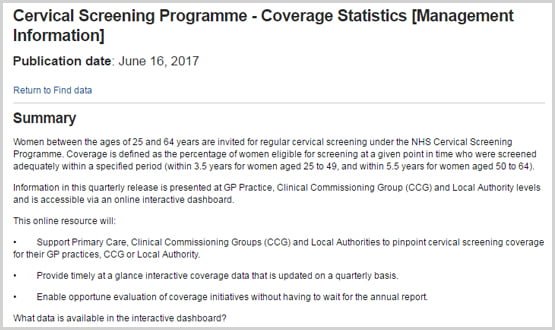NHS Digital has launched an online visual tool to show the number of women in each area who have had a cervical screening test, in a bid to help halt falling attendance numbers.
Released 16 June, the interactive data tool has been created by NHS Digital, Public Health England (PHE) and Jo’s Cervical Cancer Trust.
Pritpal Rayat, analytical section head and responsible statistician for screening and immunisations at NHS Digital, said in a statement that the dashboard will “make more timely information available about this important area in greater detail than ever before”.
“We hope this useful online resource will help support and empower GP practices, local authorities and CCGs to improve cervical screening attendance and coverage, thus ensuring more of those at risk of cervical cancer are diagnosed as early as possible.”
The cervical screening (“smear”) test is offered to women every three to five years depending on their age, but the number of women attending for a test has fallen consecutively in the last two years.
In March 2016, 73% of women aged 25-64 had a smear test, down from 73.5 per cent in 2015, and 75.7 per cent in 2011.
Ruth Stubbs, national cervical screening programme manager at PHE, said the information will “provide invaluable, timely data for GPs, CCGs and local authorities to continue to support those regions where participation levels could be improved”.
Robert Music, chief executive of Jo’s Cervical Cancer Trust, said the tool provides GPs and commissioners with a “valuable resource to benchmark their own performance, look to higher performing areas for inspiration and fully evaluate the success of activities they have undertaken”.
“If attendance continues to fall we are going to see increased diagnoses and deaths across the country and this simply cannot and should not happen.”
The data tool arrives just weeks after NHS Digital released a GP Data Hub to allow GP data to be easily visualised.
Over the next six months NHS Digital will add more figures from a variety of health areas onto the hub.
“Currently it has Qualities Outcomes Framework (QOF) data, patient list size, as well as indicators about people with learning disabilities,” an NHS Digital spokesman said.
Secondary care is also looking at using data analytics to improve its care.
Global digital exemplar trust Salford Royal NHS Foundation Trust issued a notice on 23 May to find a supplier to create a “digital control centre” that focuses on data analytics and digital health.
The information notice said: “Salford Royal is looking to the future of healthcare and wants to establish a digital control centre, bringing the latest advances in data analytics and digital health to achieve a world-leading organisation.”

